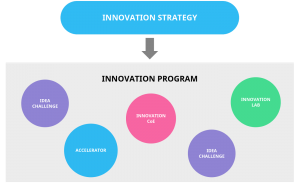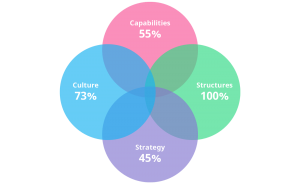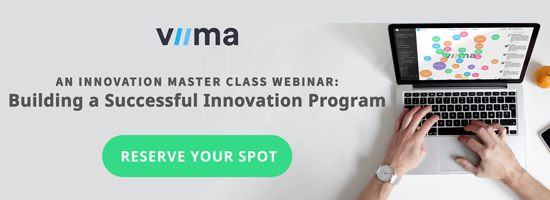Why Do So Many Innovation Programs Fail?
Whenever we talk to executives and ask how their past innovation efforts have succeeded, we usually get quite a muted response.
Most have tried at least some innovation initiatives or programs, and many have had positive experiences from some of them, but overall the end result often seems to be a bit of a disappointment.

These executives aren’t alone. According to McKinsey’s Global Innovation Survey, only 6% of executives are satisfied with their innovation performance.
Unrealistically high expectations from all the innovation hype might naturally be a part of the story behind this figure, but it’s still safe to say that these organizations have plenty of room for improvement in innovation management.
In this post, we’ll look at some of the most common challenges and mistakes that lead organizations to fail with their innovation programs.
As building a successful corporate innovation program is quite a complex challenge, this is a great first step for getting on the right path. If you’re interested in the topic, we’ll be covering it in more detail in an upcoming webinar that we’re organizing together with Innovation Excellence.
What do we mean with an innovation program?
Before we delve deeper into the challenges, it’s probably a good idea to clarify what we mean by an innovation program as the term is often used quite liberally with different meanings.
In essence, innovation program is an umbrella term for programs and projects that organizations create with the goal of creating new innovations and building their innovation capabilities.
The term is often used to refer to individual projects, but we prefer to think of innovation programs as the larger mission of organizing individual initiatives, that aim to create innovation, into a cohesive whole.
Innovation programs typically consist of a number of separate but intertwined innovation initiatives, such as innovation labs, intrapreneur programs, centers of excellence (CoE), accelerators and idea challenges.

A failed innovation program, then, is simply any innovation program that leads to disappointing results in terms of failing to meet expectations or reaching predetermined goals.
Why do innovation programs fail?
What makes innovation so tough is that for an innovation program to be successful, the organization has to get a lot of things right, while still adapting to their individual circumstances.
There are always plenty of challenges that can each become barriers preventing the innovation program from succeeding.
Or, to borrow the Anna Karenina Principle:
â€All successful innovation programs are alike; each unsuccessful innovation program is unsuccessful in its own way.â€
What that means is that while there isn’t a single strategy, solution or initiative that would help organizations magically become innovative.
All successful innovation programs are alike in the sense that they’ve managed to build a system where innovation thrives, and where there aren’t any major obstacles preventing innovation from happening.
The failed innovation programs, on the other hand, can fail for an endless number of different reasons.
For some, culture might become that barrier, for others it might be the decision-making processes and organizational structures, or the lack of (financial and human) resources for implementing their ideas.
What, then, are the most common causes for these failures?
While it’s impossible to anticipate all potential challenges beforehand, it’s still a good idea to know what the most common ones are so that you can address these in the design of your innovation program.
We’ve looked at around a dozen of the largest publicly available studies outlining the factors with the biggest negative or positive impact to innovation success and have aggregated the results for you.

As we suspected, there was quite a wide range of factors spread over all four of the major aspects of innovation.
While no individual factor was mentioned in all of the studies, at least one structural aspect, which are the more practical things such as methods and processes, was mentioned as a significant factor in all of the studies. 
What the stats tell us is simply that the reason an innovation program fails is usually a combination of different factors from two or three of these aspects.
Structures, which are the more practical things such as processes, decision-making and organizational structures, were the most common factor simply because there’s such a wide range of things that can go wrong there.
That doesn’t mean that it would always be the most important thing preventing innovation from happening, just that it usually plays some role in the process.
Regardless, structures can easily turn into barriers that stifle enthusiasm and prevent innovation from happening, especially in incumbent organizations where there are plenty of them in place to make current operations more efficient and reliable.
In the end, the key takeaway here is that for the program to succeed, all four aspects must be aligned with one another.
â€For the innovation program to succeed, all four aspects must be aligned with one another.â€
For example, if your strategy is to focus on incremental innovation in your current industry, your innovation strategy, structures, processes, capabilities and even culture, should look very different from another organization that is looking to break into and disrupt an entirely different industry.
Conclusion
Even though it certainly isn’t easy to get all of these factors to align with one another, we’ve seen quite a few organizations achieve that. In essence, the key is to have a holistic approach focused on getting the big picture right and then persistently removing barriers on the way.
While it may sound simple on paper, that usually isn’t the case in real life. Throughout our years in the business, we’ve picked up quite a few useful lessons on building successful innovation programs.
If you’d like to learn more about the theme, I’d recommend joining the upcoming webinar that we’re hosting on it.
We’ll dive deeper into some of these challenges and will also share a practical step-by-step guide to building a successful innovation program, as well as actionable tips and best practices for building the momentum once you’re off the ground.
Click here to reserve your spot.
This article was originally published in Viima’s blog.
Wait! Before you go…
Choose how you want the latest innovation content delivered to you:
- Daily — RSS Feed — Email — Twitter — Facebook — Linkedin Today
- Weekly — Email Newsletter — Free Magazine — Linkedin Group
 Jesse Nieminen is the Co-founder and Chairman at Viima, the best way to collect and develop ideas. Viima’s innovation management software is already loved by thousands of organizations all the way to the Global Fortune 500. He’s passionate about helping leaders drive innovation in their organizations and frequently writes on the topic, usually in Viima’s blog.
Jesse Nieminen is the Co-founder and Chairman at Viima, the best way to collect and develop ideas. Viima’s innovation management software is already loved by thousands of organizations all the way to the Global Fortune 500. He’s passionate about helping leaders drive innovation in their organizations and frequently writes on the topic, usually in Viima’s blog.
NEVER MISS ANOTHER NEWSLETTER!
LATEST BLOGS
The Incredible Shrinking Laptop
As technology advances and people’s demands for ever-thinner, ever-lighter laptops increase, more and more the thickness of a laptop is…
Read MoreA Revolution in Management Consulting?
Management consulting firms are built on a model that requires the maintenance of a bench of their people to staff…
Read More



